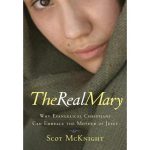McKnight, Scot. The Real Mary: Why Evangelicals Can Embrace the Mother of Jesus. Paraclete Press, 2007. ISBN: 9781557255235.
Meet the Author
 Scot McKnight is an Anabaptist theologian and a professor of religious studies at Northpark University. The author of over 20 books, he specializes in Jesus studies and the New Testament. As an authority in Jesus studies, McKnight has been frequently consulted by Fox News, WGN, US News & World Report, Newsweek, and TIME. McKnight is active in the online community and often makes posts to his blog several times a day.
Scot McKnight is an Anabaptist theologian and a professor of religious studies at Northpark University. The author of over 20 books, he specializes in Jesus studies and the New Testament. As an authority in Jesus studies, McKnight has been frequently consulted by Fox News, WGN, US News & World Report, Newsweek, and TIME. McKnight is active in the online community and often makes posts to his blog several times a day.
I have featured McKnight’s writings on many occasions: a review of Fasting (2009), a consideration of The Jesus Creed (2004), and references to blog topics.
Book Basics
The Real Mary is a call for Protestants to reconsider Mary in light of the biblical text. McKnight counts 217 verses containing “more than a dozen instances of Mary’s being mentioned” in the New Testament (p. 106).
Structurally, the book is divided into three parts: 
- The Real Mary of the Gospels. Chapter by chapter and story by story, the reader is confronted with a biblical picture of Mary that differs widely from the commonly held and often presented Christmas story view of a passive and willing teenager and that is equally at odds with some of the Roman Catholic perspectives. Mary is a woman of deep faith who grows and is transformed by her experiences as the mother of Jesus and as a disciple of Jesus.
- The Ongoing Life of Mary in the Church. Mary’s influential presence can be seen in the teachings of her sons (Jesus and James), in the New Testament, and in the earliest churches. McKnight also explores the development of Roman Catholic tradition about Mary and encourages Protestants to consider the developments in light of the Roman Catholic understanding of tradition.
- Embracing the Real Mary. In response to a renewed biblical vision of Mary, McKnight invites his readers to consider embracing Mary for who she really was as the mother of Jesus and as a woman of faith who “struggles and learns and grows” in response to her experiences of Jesus (p. 144).
So What?
If you were interviewed by a new Christian who wanted to know more about Mary, would you feel able to answer biblically? Have you ever stopped to consider what sources have contributed to your current view of Mary?
In his final chapter, McKnight goes as far as suggesting that Protestant churches have an “Honor Mary Day”. For this occasion he suggests we “gather together in discussion to examine once again what the Bible actually says about the real Mary” (p.144). What would such an event look like in your congregation? Would you be willing to consider it? If not, why not?